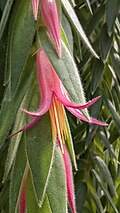| Image | Scientific name | Distribution |
|---|
| Ceratostema agettiorum M.M.Jiménez & H.Garzón | Ecuador (Morona-Santiago) |
 | Ceratostema alatum (Hoerold) Sleumer | Colombia, Ecuador |
| Ceratostema amplexicaule A.C.Sm. | Colombia, Ecuador |
| Ceratostema auriculatum Luteyn | Ecuador (Zamora-Chinchipe) |
| Ceratostema bracteolatum Luteyn | Ecuador (Azuay) |
| Ceratostema callistum A.C.Sm. | Peru |
| Ceratostema calycinum (A.C.Sm.) Sleumer | Ecuador |
| Ceratostema charianthum A.C.Sm. | Ecuador |
| Ceratostema cutucuense Luteyn | Ecuador (Morona-Santiago) |
| Ceratostema fasciculatum Luteyn | Ecuador. |
| Ceratostema ferreyrae Luteyn | Peru |
| Ceratostema glandulifera Maguire, Steyerm. & Luteyn | Venezuela. |
 | Ceratostema glans Luteyn | Ecuador (Morona-Santiago) |
 | Ceratostema gualaquizensis M.M.Jiménez & H.Garzón | Ecuador (Morona-Santiago) |
| Ceratostema jorgebritoi M.M.Jiménez & h.Garzón | Ecuador (Morona-Santiago) |
| Ceratostema lanceolatum Benth. | Ecuador (Loja) |
 | Ceratostema lanigerum (Sleumer) Luteyn | Ecuador. |
| Ceratostema loranthiflorum Benth. | Ecuador. |
| Ceratostema loucianae Cornejo, G. Tello & Luteyn | Ecuador (Morona-Santiago) |
| Ceratostema macbrydiorum Luteyn | Ecuador (Morona-Santiago) |
| Ceratostema madisonii Luteyn | Ecuador (Morona-Santiago) |
| Ceratostema megabracteatum Luteyn | Ecuador |
| Ceratostema megalobum Luteyn | Ecuador (Loja) |
| Ceratostema nodosum Luteyn | Ecuador |
| Ceratostema nubigena (A.C.Sm.) A.C.Sm. | Ecuador |
 | Ceratostema oellgaardii Luteyn | Ecuador (Loja) |
| Ceratostema oyacachiensis Luteyn [6] | Ecuador (Napo) |
| Ceratostema pedunculatum Luteyn | Ecuador (Zamora-Chinchipe) |
 | Ceratostema pendens Luteyn [6] | Ecuador (Morona-Santiago) |
| Ceratostema pensile (A.C.Sm.) A.C.Sm. | Ecuador (El Oro) |
 | Ceratostema peruvianum Pers. | Ecuador. |
| Ceratostema prietoi A.C.Sm. | Ecuador (Cañar) |
| Ceratostema pubescens Luteyn [6] | Ecuador (El Oro) |
 | Ceratostema rauhii Luteyn | Peru. |
| Ceratostema reginaldii (Sleumer) A.C.Sm. | Ecuador |
| Ceratostema sieteiglesiana Garzón & M.M.Jiménez | Ecuador (Morona-Santiago) |
| Ceratostema silvicola A.C.Sm. | Ecuador |
| Ceratostema speciosum André | Ecuador. |
| Ceratostema ventricosum A.C.Sm. | Ecuador |
| Ceratostema zamorana M.M.Jiménez & Vélez-Abarca | Ecuador (Zamora-Chinchipe) |
|








